第六届“认证杯”数学中国
数学建模国际赛
承 诺 书
我们仔细阅读了第六届“认证杯”数学中国数学建模国际赛的竞赛规则。
我们完全明白,在竞赛开始后参赛队员不能以任何方式(包括电话、电子邮
件、网上咨询等)与队外的任何人(包括指导教师)研究、讨论与赛题有关的问
题。
我们知道,抄袭别人的成果是违反竞赛规则的, 如果引用别人的成果或其他
公开的资料(包括网上查到的资料),必须按照规定的参考文献的表述方式在正
文引用处和参考文献中明确列出。
我们郑重承诺,严格遵守竞赛规则,以保证竞赛的公正、公平性。如有违反
竞赛规则的行为,我们将受到严肃处理。
我们允许数学中国网站(www.madio.net)公布论文,以供网友之间学习交流,
数学中国网站以非商业目的的论文交流不需要提前取得我们的同意。
我们的参赛队号为:3806
我们选择的题目是: B
参赛队员 (签名) :
队员 1: 郁振东
队员 2: 李开颜
队员 3: 温正峤
参赛队教练员 (签名): 无
�
Team # 3806
Page 2 of 17
第六届“认证杯”数学中国
数学建模国际赛
编 号 专 用 页
参赛队伍的参赛队号:(请各个参赛队提前填写好):
3806
竞赛统一编号(由竞赛组委会送至评委团前编号):
竞赛评阅编号(由竞赛评委团评阅前进行编号):
�
Team # 3806
Page 3 of 17
Authorship Attribution System Based on SVM
Abstract:
With the development of the investigation methods and many language evidence
appears in E-mails, we can use handwriting analysis to identify the authorship by
linguistic features of the E-mail. Studying the relationship between authorship and
word frequency, word formation of E-mail, identify the authorship would be more
efficiently and more quickly. Many successful techniques like stylometric features and
grammatical rules extraction have been invented for authorship attribution of literary
works. Due to informality and short size of E-mails, these techniques cannot perform
well in e-mail authorship attribution.
In consideration of this situation, in this paper, through the idea of machine
learning, we chose part of speech of words as the feature for per E-mail and found the
relationship between the authorship and part of speech, so as to analyse the
relationship between E-mails and authorship to identify whether or not the E-mail
comes from particular person. Part of speech was differentiated into 36 kinds, each
part of speech corresponds to specific symbol refereed to the Table in Appendix. In
our study, we found that there was no LS in all 1600 E-mails, therefore, we adopted
35-dimensions model as final machine learning model. Finally, after testing the
accuracy can reach 97.2561%.
We divided all 1600 E-mails(about 1000 E-mails come from Steven Kean, 600
E-mails come from other person) downloaded into two parts randomly.One is used to
extract the features of E-mail and as the train set for machine learning, taking up 80%
of all E-mails. 20% E-mails left are used as test set for machine learning. In order to
extract the features of E-mail, we take advantage of TextBlob toolkit to split, tag,
normalize the E-mails, in order to acquire the times of words with different parts of
speech finally. After acquiring the statistics, SVM classifier model was used to learn
the different parts between Steve Kean’s E-mails and other person’s, then we did a
test after learning all 80% of E-mails, the accuracy reached above 97.2561%. In order
to sum the relationship between the accuracy and training samples size, we designed a
contrast test: we chose 90%, 80%, 70%, 60%, 50%, 40% amount of training samples
to train, got the different of accuracy in 10 test times, draw up the line chart in
Figure2. From the Figure2, we concluded that: the accuracy increases if the amounts
of training samples increase, however, the more amounts of training samples was
trained, the higher variance of accuracy we got.
Key words: Handwriting analysis、Machine Learning、part of speech
�
Team # 3806
Page 4 of 17
Contents
I. Introduction...............................................................................................................5
1.1 Problem Description..........................................................................................5
1.2 Terminology and Definition..............................................................................5
1.3 Our Work...........................................................................................................5
II. The Description of the Problem............................................................................. 5
2.1 Feature Extraction............................................................................................. 5
2.1.1 Splitting and Tagging.............................................................................. 5
2.1.2 Statistic and Normalization..................................................................... 5
2.2 Machine Learning..............................................................................................6
III. Models.....................................................................................................................6
3.1 Flow Chart.........................................................................................................6
3.2.1 Definitions and Symbols......................................................................... 7
3.2.2 Assumptions............................................................................................ 7
3.2.3 The Foundation of Model........................................................................7
3.2.4 Solution and Result Analysis.................................................................. 8
3.2.5 Strength and Weakness........................................................................... 9
3.3 Machine Learning Model.................................................................................. 9
3.3.1 Definitions and Symbols......................................................................... 9
3.3.2 The Foundation of Model......................................................................10
3.3.3 Solution and Result Analysis................................................................ 11
3.3.4 Strength and Weakness......................................................................... 13
IV. Conclusions...........................................................................................................13
4.1 Conclusions of the Problem............................................................................ 13
4.2 Methods Used in Our Models......................................................................... 13
4.3 Applications of Our Models............................................................................13
V. Future Work.......................................................................................................... 13
Model Promotion...................................................................................................13
VI. References.............................................................................................................14
VII. Appendix............................................................................................................. 14
7.1 Tag Description.............................................................................................. 14
7.2 Codes..............................................................................................................15
�
Team # 3806
Page 5 of 17
I. Introduction
1.1 Problem Description
Handwriting analysis has been used in criminal investigation for a long time to
link people to written evidence. In law cases, we can take advantage of handwriting
analysis to find out the criminal suspect accurately and quickly. However, with the
spread of World Wide Web, E-mail has changed our way of written communication.
With the increase of E-mail traffic, the use of E-mail for illegitimate purpose such as
spamming, threatening, illegal transaction etc, also has an increasing trend. Therefore,
handwriting analysis is also applied widely on law cases, to match the authorship and
E-mail.
Through the study and development of recent years, handwriting analysis’s
maturity have got a huge promotion. The main difficulty of handwriting analysis is
how to extract the E-mail’s features appropriately and precisely when the E-mails
appear with different formats, lengths or some other situations. Word frequency,
lexical, syntactic, structural, grammatical features, and other features have been
researched in various paper on Literary. However, due to unreliable values, these large
numbers of features remain redundant and lower accuracy of an authorship attribution
system by creating noise, value of these stylometric and grammatical features cannot
be calculated reliably.
1.2 Terminology and Definition
(1) SVM(support vector machine): A model of supervised learning to process pattern
recognition, classification and regression analysis in machine learning.
(2) TextBlod: A tool kit supporting Python2 and Python3 used to process textual data.
1.3 Our Work
(1) Use TextBlob toolkit to extract the feature(part of speech), gain the time of
occurrence of different parts of speech, normalize the statistic.
(2)Use SVM classifier for learning and judgement by the statistic extracted above.
(3)Design contrast test to gain the different accuracy rates with different amounts of
training samples, evaluate model and optimize algorithm to improve accuracy .
II. The Description of the Problem
2.1 Feature Extraction
2.1.1 Splitting and Tagging
Each E-mail content should be split into independent words on account of text
file’s data structure. Those words can be identified independently, then will be sent to
tag its part of speech.
2.1.2 Statistic and Normalization
�
Team # 3806
Page 6 of 17
After tagging per word in per E-mail, statistic about the time of occurrence of
various parts of speech should be acquired, so that, we can get the information from
the statistic. Normalization is the last procedure to process the data we got.
2.2 Machine Learning
There are about 1600 E-mails downloaded from specified website , about 1000
E-mails come from a person called Steven Kean, left come from others. Those 1600
E-mails would be divided to two parts randomly for training and testing. Getting a
E-mail from test set randomly as testing sample, we can use this sample to examine
whether the model built has the ability to estimate the chosen E-mail came from
Steven Kean or not.
III. Models
3.1 Flow Chart
3.2 Feature Extraction Model
3.2.1 Definitions and Symbols
Symbols
}{A
}{B
max()
m
Definitions
set A, for training
set B ,for testing
function to get the maximum
max amount of part of speech
3.2.2 Assumptions
(1)The E-mails’ annotations are the same in all E-mails.
�
Team # 3806
Page 7 of 17
(2)The E-mails do not contain messy codes, useless characters.
3.2.3 The Foundation of Model
First, we divided E-mail datasets downloaded into two sets(called set A and set
B ). Set A is used as the train set for machine learning model. Set B is used as test set
for machine learning model.
Second, we called the TextBlob toolkit to split E-mails’ content in set A to
independent words, so as to accomplish part of speech tagging successfully and easily.
After all E-mails’ independent words in set A was tagged, we calculated the times of
occurrence of various parts of speech per E-mail, then list them out.
Third, we took the highest time of occurrence of part of speech as unit one,
normalize part of speech left successively, then list them out like Table1.
Table1.Fragment of statistic after normalizing
52759
53555
1.00000
0.33333
1.00000
0.42254
0.14634
0.15493
0.18699
0.09756
0.16901
0.02817
0.12195
0.05634
0.21951
0.02439
0.01408
0.01408
0.00000
0.01408
0.11382
0.04878
0.02817
0.00000
0.14634
0.04225
0.13821
0.08130
0.05634
0.05634
0.21138
0.11268
0.07317
0.01626
0.07042
0.00000
0.04878
0.02817
0.01626
0.04878
0.02817
0.07042
0.00000
0.00000
0.00813
0.00813
0.00000
0.00000
0.00000
0.00000
0.00813
0.00000
54536
1.00000
0.33155
0.10160
0.35829
0.06417
0.12834
0.08021
0.11230
0.02139
0.08021
0.03209
0.16043
0.31551
0.08021
0.17647
0.12299
0.08021
0.04813
0.07487
0.13369
0.00000
0.00000
0.01070
0.00535
0.00535
54539
54542
1.00000
1.00000
0.54545
0.48529
0.20455
0.10294
0.11364
0.27206
0.11364
0.04412
0.02273
0.08088
0.02273
0.07353
0.00000
0.02206
0.04545
0.02206
0.15909
0.11029
0.02273
0.05147
0.02273
0.08088
0.04545
0.11029
0.09091
0.04412
0.06818
0.13971
0.02273
0.03676
0.04545
0.01471
0.02273
0.14706
0.02273
0.10294
0.20455
0.26471
0.00000
0.01471
0.00000
0.00000
0.00000
0.00000
0.00000
0.00000
0.00000
0.00000
NN
JJ
CD
IN
VBZ
TO
NNP
VBD
FW
VBP
VBG
PRP
DT
MD
VB
RB
VBN
CC
PRP$
NNS
JJS
WDT
WP
PDT
WRB
�
Team # 3806
Page 8 of 17
POS
JJR
RP
RBR
EX
UH
RBS
SYM
WP$
NNPS
0.08130
0.01408
0.00813
0.00000
0.00000
0.00000
0.00000
0.00000
0.00813
0.00000
0.00000
0.00000
0.00000
0.00000
0.00000
0.00000
0.00000
0.00000
0.00000
0.00000
0.01070
0.01604
0.00000
0.00535
0.00000
0.00000
0.00000
0.00000
0.00000
0.00000
0.00000
0.00735
0.00000
0.00000
0.00000
0.00000
0.00000
0.00000
0.00000
0.00000
0.00000
0.00000
0.00000
0.00000
0.00000
0.00000
0.00000
0.00000
0.00000
0.00000
The first column of Table1 represents various parts of speech’s symbol, the first
row of Table1 represents E-mails’ serial number.
3.2.4 Solution and Result Analysis
(1)Solution of model
Algorithm for statistic:
1.Input: E-mail i, total train samples m, amounts of part of speech n, amounts of per
part of speech: CC,JJ,RB,.........
{
{
openfile[i];
for(j=1,j

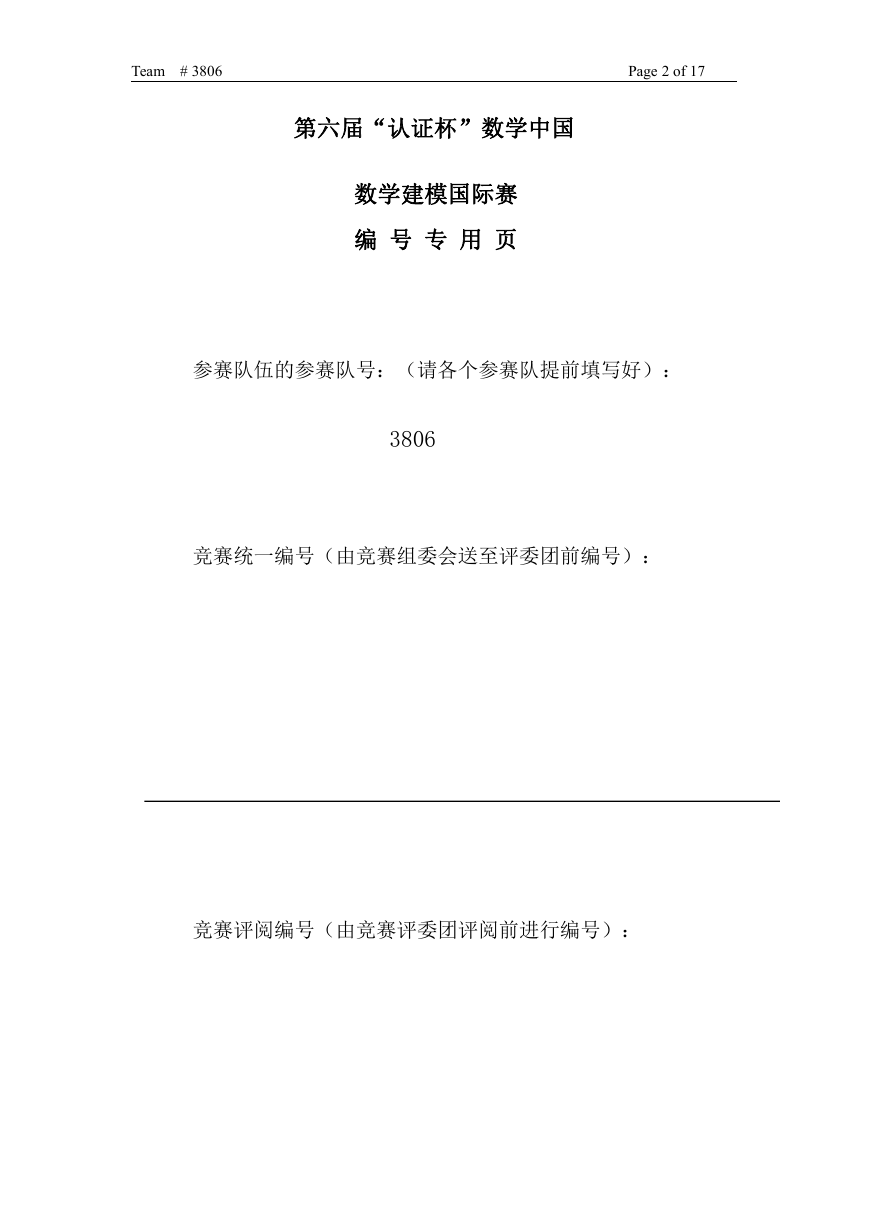

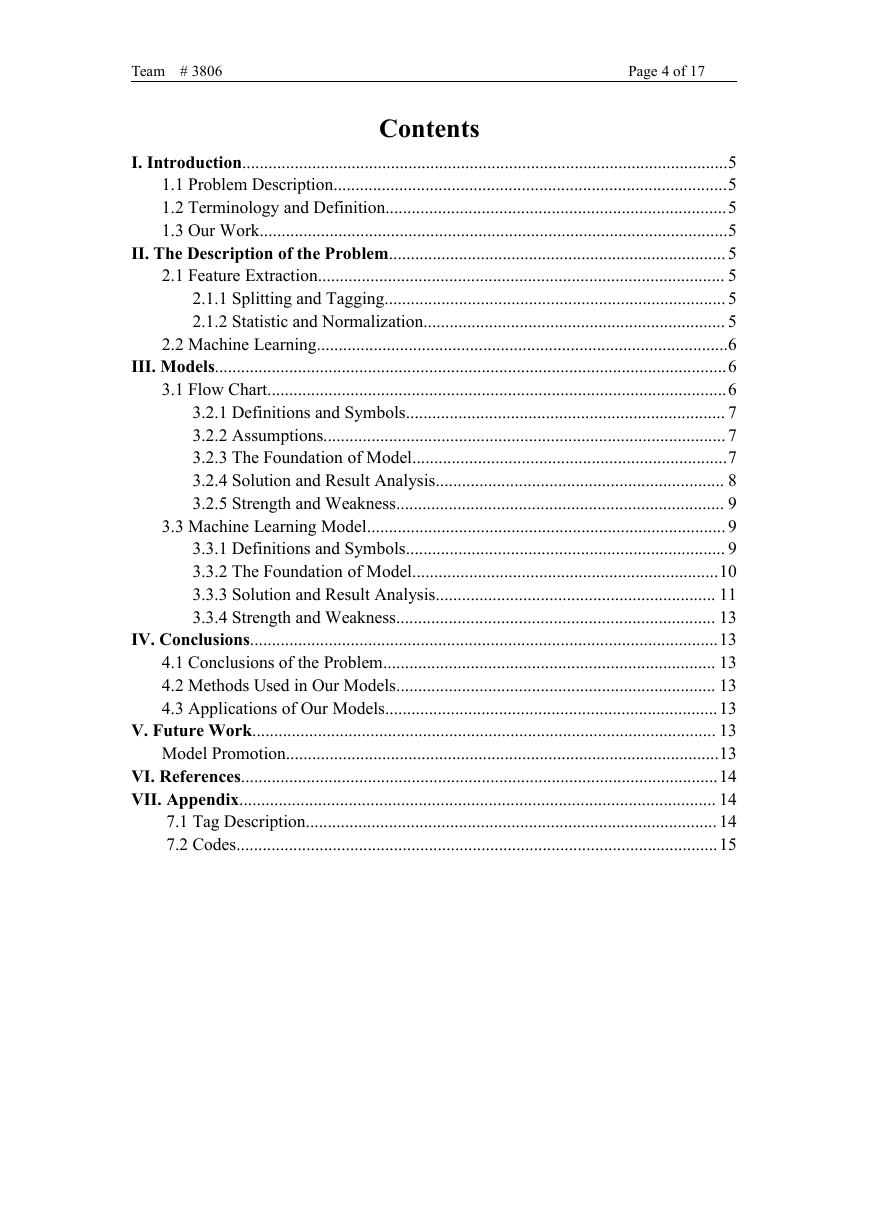
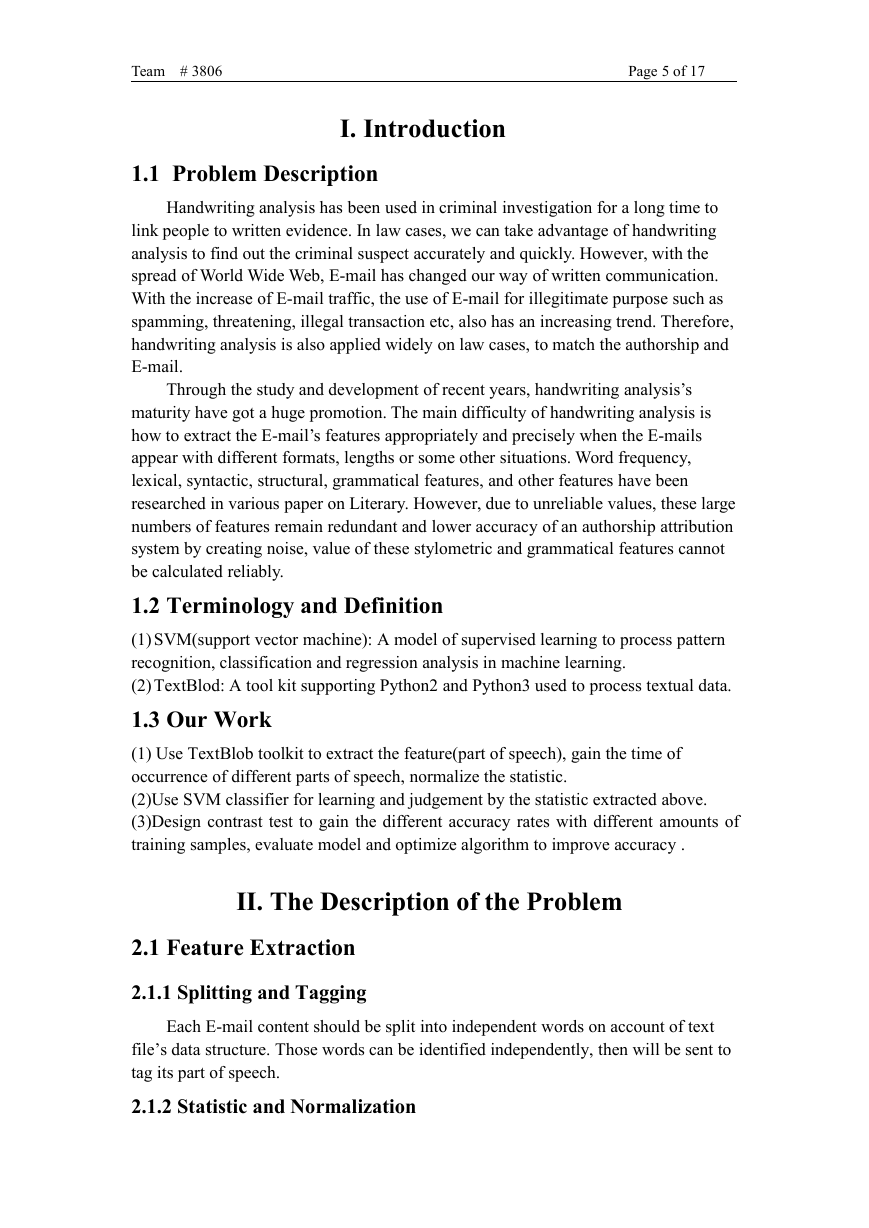
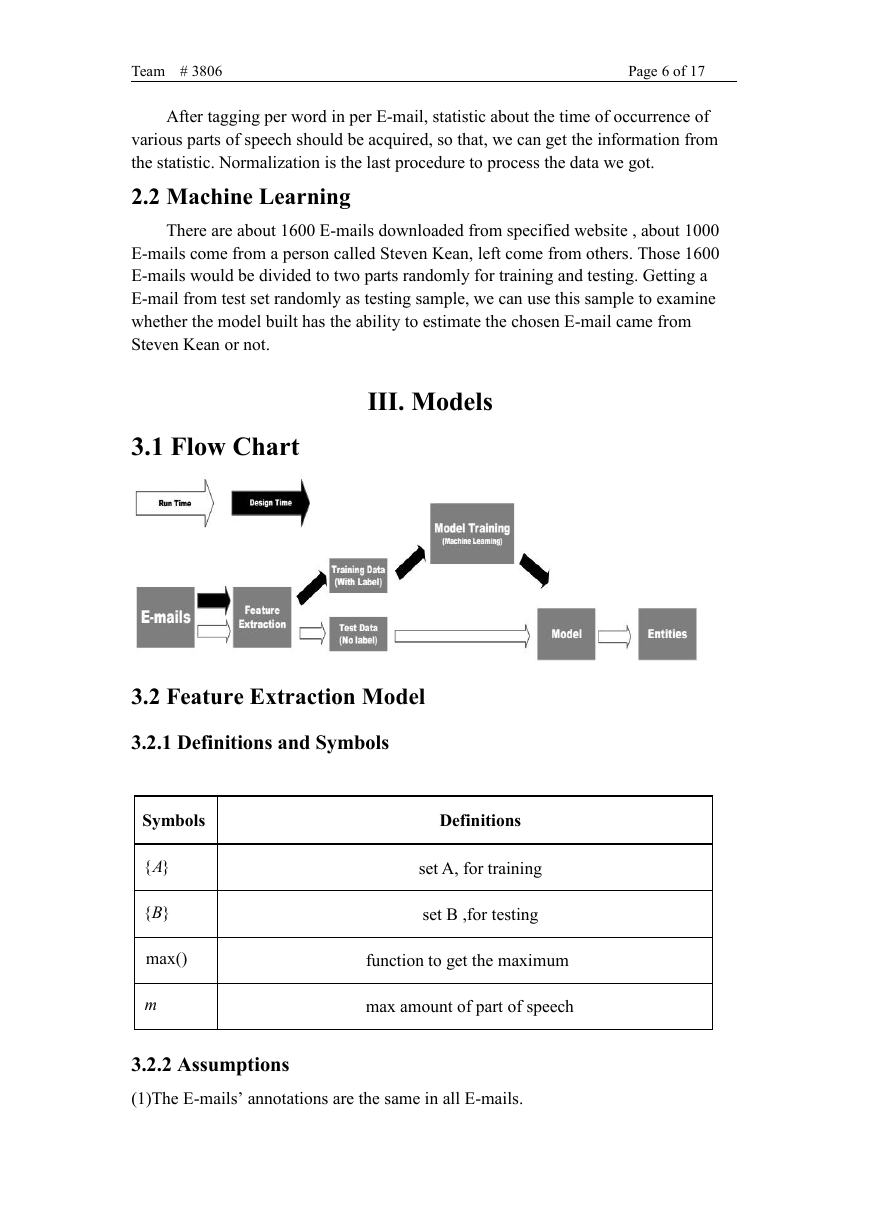

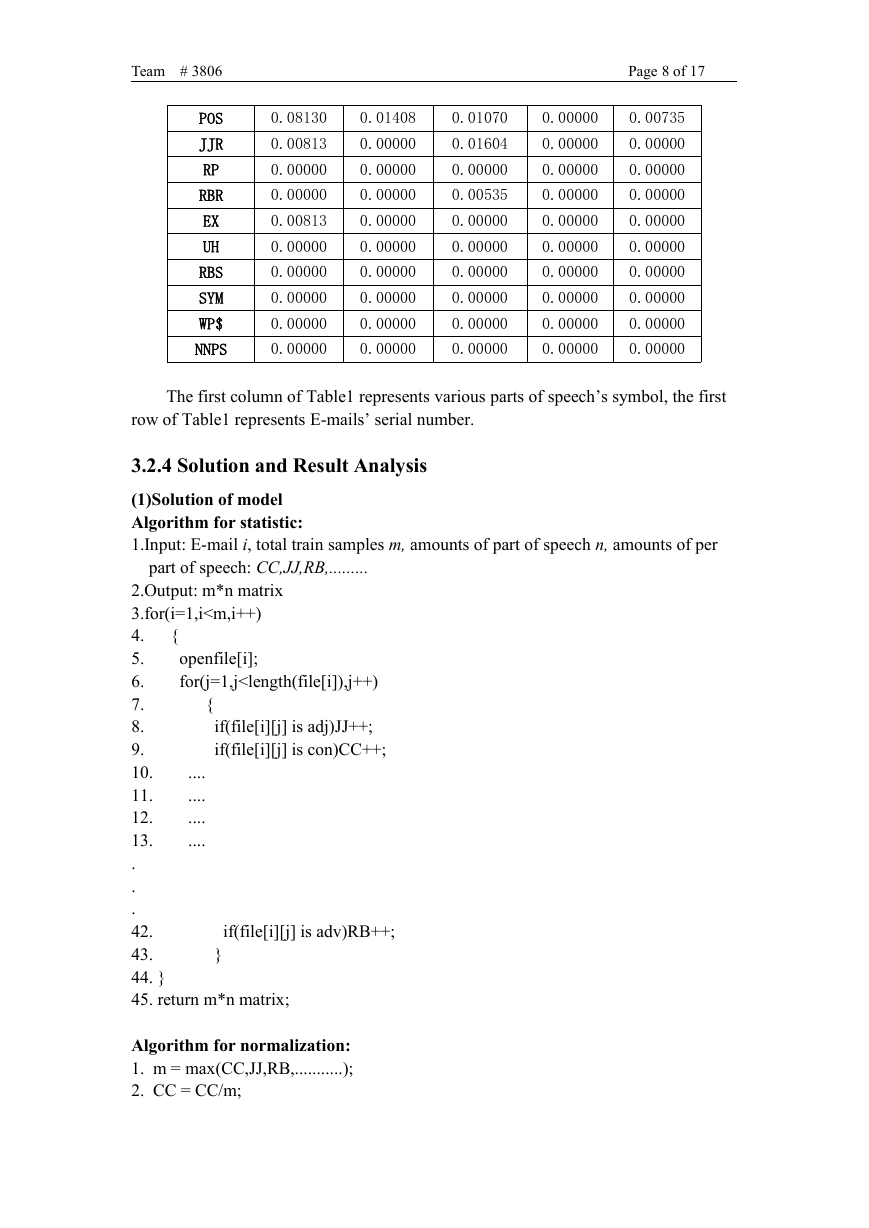








 2023年江西萍乡中考道德与法治真题及答案.doc
2023年江西萍乡中考道德与法治真题及答案.doc 2012年重庆南川中考生物真题及答案.doc
2012年重庆南川中考生物真题及答案.doc 2013年江西师范大学地理学综合及文艺理论基础考研真题.doc
2013年江西师范大学地理学综合及文艺理论基础考研真题.doc 2020年四川甘孜小升初语文真题及答案I卷.doc
2020年四川甘孜小升初语文真题及答案I卷.doc 2020年注册岩土工程师专业基础考试真题及答案.doc
2020年注册岩土工程师专业基础考试真题及答案.doc 2023-2024学年福建省厦门市九年级上学期数学月考试题及答案.doc
2023-2024学年福建省厦门市九年级上学期数学月考试题及答案.doc 2021-2022学年辽宁省沈阳市大东区九年级上学期语文期末试题及答案.doc
2021-2022学年辽宁省沈阳市大东区九年级上学期语文期末试题及答案.doc 2022-2023学年北京东城区初三第一学期物理期末试卷及答案.doc
2022-2023学年北京东城区初三第一学期物理期末试卷及答案.doc 2018上半年江西教师资格初中地理学科知识与教学能力真题及答案.doc
2018上半年江西教师资格初中地理学科知识与教学能力真题及答案.doc 2012年河北国家公务员申论考试真题及答案-省级.doc
2012年河北国家公务员申论考试真题及答案-省级.doc 2020-2021学年江苏省扬州市江都区邵樊片九年级上学期数学第一次质量检测试题及答案.doc
2020-2021学年江苏省扬州市江都区邵樊片九年级上学期数学第一次质量检测试题及答案.doc 2022下半年黑龙江教师资格证中学综合素质真题及答案.doc
2022下半年黑龙江教师资格证中学综合素质真题及答案.doc